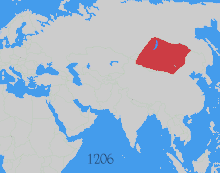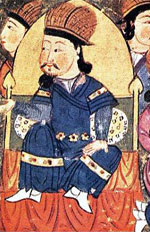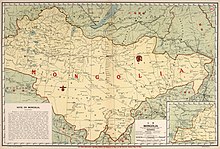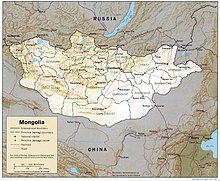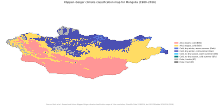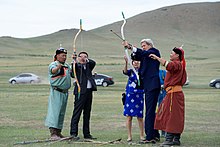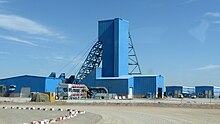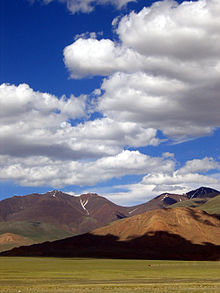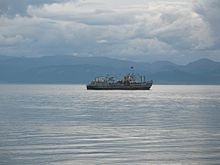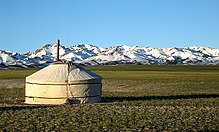Mongolia
Mongolia is the world's largest landlocked country that does not border a closed sea, and much of its area is covered by grassy steppe, with mountains to the north and west and the Gobi Desert to the south.
Mongolia is a member of the United Nations, Asia Cooperation Dialogue, G77, Asian Infrastructure Investment Bank, Non-Aligned Movement and a NATO global partner.
In the thirteenth century, the word Mongol grew into an umbrella term for a large group of Mongolic-speaking tribes united under the rule of Genghis Khan.
[18][19] The Khoit Tsenkher Cave[20] in Khovd Province shows lively pink, brown, and red ochre paintings (dated to 20,000 years ago) of mammoths, lynx, bactrian camels, and ostriches, earning it the nickname "the Lascaux of Mongolia".
Neolithic agricultural settlements (c. 5500–3500 BC), such as those at Norovlin, Tamsagbulag, Bayanzag, and Rashaan Khad, predated the introduction of horse-riding nomadism, a pivotal event in the history of Mongolia which became the dominant culture.
Common institutions were the office of the Khan, the Kurultai (Supreme Council), left and right wings, imperial army (Keshig) and the decimal military system.
[31] The next centuries were marked by violent power struggles among various factions, notably the Genghisids and the non-Genghisid Oirats, as well as by several Ming invasions (such as the five expeditions led by the Yongle Emperor).
The main trade route during this period was the Tea Road through Siberia; it had permanent stations located every 25 to 30 kilometres (16 to 19 mi), each of which was staffed by 5–30 chosen families.
Ambans, Manchu "high officials", were installed in Khüree, Uliastai, and Khovd, and the country was divided into numerous feudal and ecclesiastical fiefdoms (which also placed people in power with loyalty to the Qing).
The behavior of Mongolia's nobility, together with usurious practices by Chinese traders and the collection of imperial taxes in silver instead of animals, resulted in widespread poverty among the nomads.
In 1924, after the Bogd Khaan died of laryngeal cancer[37] or, as some sources claim, at the hands of Russian spies,[38] the country's political system was changed.
Khorloogiin Choibalsan instituted collectivization of livestock, began the destruction of the Buddhist monasteries, and carried out Stalinist purges, which resulted in the murders of numerous monks and other leaders.
All leaders of Mongolia who did not fulfill Stalin's demands to perform Red Terror against Mongolians were executed, including Peljidiin Genden and Anandyn Amar.
The cold gets less severe as one goes south, reaching the warmest January temperatures in Omnogovi Province (Dalanzadgad, Khanbogd) and the region of the Altai mountains bordering China.
[61] Gobi rangelands are fragile and easily destroyed by overgrazing, which results in expansion of the true desert, a stony waste where not even Bactrian camels can survive.
[89] On May 31, 2023, Mongolia's parliament approved a constitutional amendment that increased the number of seats from 76 to 126 and changed the electoral system re-introducing proportional party voting.
After defeating incumbent Nambaryn Enkhbayar, Tsakhiagiin Elbegdorj, a two-time former prime minister and member of the Democratic Party, was elected as president on 24 May 2009 and inaugurated on 18 June that year.
[106] Mongolia is also pursuing a trilateral partnership with China and Russia through the Power of Siberia 2 natural gas pipeline, with a contract to be signed in the "near future" according to Russian Deputy Prime Minister Alexander Novak.
[109] It has begun seeking positive relations with a wider range of other countries especially in cultural and economic matters, focusing on encouraging foreign direct investment and trade.
200 Mongolian troops are serving in Sierra Leone on a UN mandate to protect the UN's special court set up there, and in July 2009, Mongolia decided to send a battalion to Chad in support of MINURCAT.
[120] Economic activity in Mongolia has long been based on herding and agriculture, although development of extensive mineral deposits of copper, coal, molybdenum, tin, tungsten and gold have emerged as a driver of industrial production.
[4] In 2009, the Mongolian government negotiated an agreement with Rio Tinto and Ivanhoe Mines to develop the Oyu Tolgoi copper and gold deposit,[121] the biggest foreign-investment project in Mongolia at the time.
[139] However, the high altitude, extreme fluctuation in temperature, long winters, and low precipitation provides limited potential for agricultural development.
The agriculture sector therefore remains heavily focused on nomadic animal husbandry with 75% of the land allocated to pasture, and cropping only employing 3% of the population.
Direct flight connections exist between Mongolia and South Korea, China, Thailand, Hong Kong, Japan, Russia, Germany, and Turkey.
The traditional music includes a variety of instruments, famously the morin khuur, and also the singing styles like the urtyn duu ("long song"), and throat-singing (khoomei).
[169] The dissolution of the Soviet Union had a significant impact on Mongolia, where the one-party state grew into a multi-party democracy, and with that, media freedoms came to the forefront.
In modern-day Mongolia, Naadam is held from July 11 to 13 in the honor of the anniversaries of the National Democratic Revolution and foundation of the Great Mongol State.
Other sports such as basketball, weightlifting, powerlifting, association football, athletics, gymnastics, table tennis, jujutsu, karate, aikido, kickboxing, and mixed martial arts have become popular in Mongolia.
Bandy is the only sport in which Mongolia has finished higher than third place at the Asian Winter Games, which happened in 2011 when the national team captured the silver medal.

